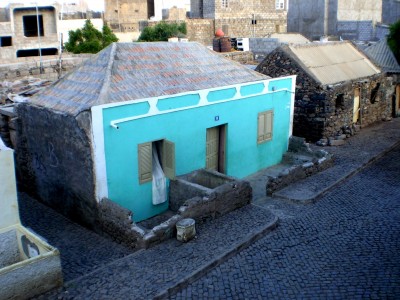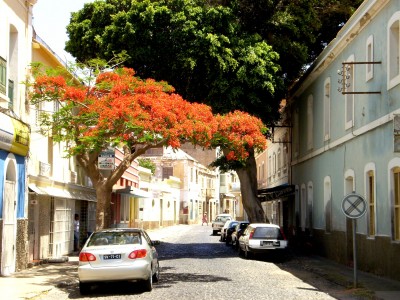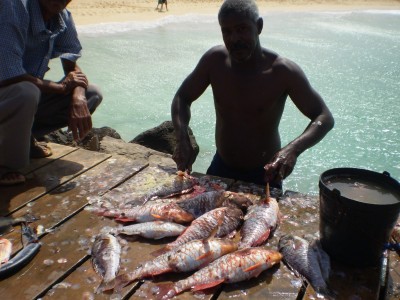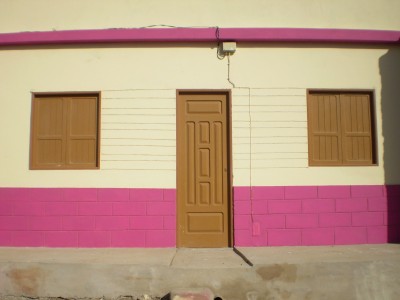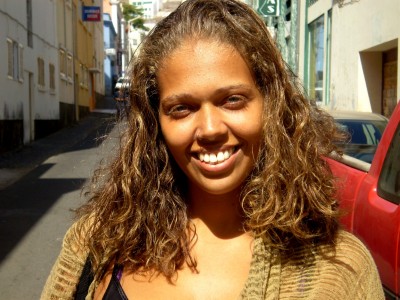by Ron Bernthal
Césaria Evora, Cabo Verde’s “Barefoot Diva,” often sang about her home, the stunningly beautiful island of São Vicente, one of the nine inhabited islands that make up the nation of Cabo Verde. When Ms. Evora died in 2011, at the age of 70, all of Cabo Verde mourned, as did much of Europe, where she spent the last months of her life.
Growing up, Ms. Evora experienced the ubiquitous poverty of Cabo Verde, an island nation with few natural resources and high unemployment. It saddened her that almost 70% of the country’s skilled workers had to leave their homes for work in other countries, disrupting family lives and cultural ties. For many Cabo Verdeans, now living abroad in Europe or the United States, sending money back to their island families is a monthly ritual, but they are hoping that current tourism and cultural development projects will finally bring true prosperity to the isolated archipelago. For the residents São Vicente, and on the other islands where overseas investors have bet on the future, that day of salvation, which looked so promising just a few years ago, has not yet arrived, and some wonder if it ever will.
Cesaria Evora – Tchintchirote [Video]
Although the official language of Cabo Verde is Portuguese (Portugal ruled these islands for 500 years) the language of the streets is Creole, a mixture of Portuguese and West African tribal languages brought to the islands when Cabo Verde became a major slave market for the hundreds of thousands of African slaves brought here before being sold by traders and loaded onto large ships for the Atlantic crossing.
With its band of sun-drenched islands assembled in a backward C shape “)” Cabo Verde lies more than 300 miles off the coast of Senegal, bathed under a warm sun for 360 days per year. In the past two decades the spectacular white or black-sand beaches of the islands have attracted a few international hotel chains, as well as middle class Europeans looking for inexpensive second homes in a destination that offers plenty of sea and sand only 4-6 hours flying time from London, Berlin or Zurich.
In the mid-2000′s the pace of tourism development accelerated, as residents of Western Europe, flush with cash from booming economies, sought exotic vacation spots. Along Cabo Verde’s once virgin beaches, and in the empty dry hills behind them, the outlines of new streets were bulldozed into the sand, and grey concrete foundations for new hotels and residential villas offered a promising future for local residents.
In Santa Maria, on the island of Sal, where tourism was once confined to a few blocks within the center of town, ribbons of new asphalt now stretch for miles into the flat desert-like terrain surrounding the town, but the number of cement trucks and construction vehicles that had once moved noisily throughout the island, leaving sun-splashed mini residential communities and hotels in their wake, has slowed considerably since spring 2020. These days Sal has more than 10,000 guest rooms to offer visitors, and is beginning to compete for leisure visitors with the Atlantic Ocean islands in the Canaries or Madeira. Still, it is a good start for a destination that hopes to emulate its Spanish competitors, at least after the investors return whenever international travel picks-up again after the pandemic eases.
With some of the highest levels of GDP contribution from tourism in Africa, it is not surprising to see that Cabo Verde, at least before the pandemic, has experienced fast growth in international arrivals. From 2005-2015, Cabo Verde arrivals increased 163% at a compound annual growth rate of 11.3 percent, well above its African competitors.
If the transformation of these out-of-the-way, volcanic islands into a major tourist destination succeeds, it will be because the Atlantic Ocean is the backdrop here, and ocean view prices for land on Cabo Verde are much lower than in southern Europe and the Caribbean. For thousands of sun starved northern Europeans, and for more and more Americans priced out of Hawaii or coastal California, the lure of Cabo Verde’s relatively affordable water-view property will become harder to resist.
The island of Sal is flat and dry and can seem quite desolate when seen for the first time. However, visitors on vacation, or those considering purchasing second homes, appreciate the beauty of its deserts and volcanic calderas, and enjoy the two main towns on the island, the fishing village turned tourist town of Santa Maria, and the island capital of Espargos.
Most tourist accommodations, including vacation properties available for purchase, are located in self-contained resorts, with some new five-star developments that have sold quickly for about $175,000. Other, less deluxe units in the center of Santa Maria were selling for a third that price.
Of the other islands, Boa Vista offers 30 miles of white sand beachfront, with a slightly greener interior than Sal. It also has a new international airport with more and more tour operators and airlines offering it as a vacation destination. Prices for small apartments start at around $65,000, with villas from $263,000. Visitors and expats seem to enjoy the nightlife and music found in Sal Rei, the largest town on the island.
The largest island in Cabo Verde is Santiago, which is more lush, tropical and mountainous than the others, with plenty of green vegetation and a eucalyptus forest. It has agricultural industry, with exports of bananas, mango and coffee. As the nation’s capital, Praia has government buildings, and is where many Cabo Verde businesses are based. It is a lively town, with many historic residential and office buildings, and with 128,000 residents it is by far the largest city in Cabo Verde.
Real estate prices in Praia range from about $105,000 for a nice apartment, to around $330,000 for a spacious, private villa. Because of the large inventory of houses available for sale in the capital, and with neighborhoods having great differences in terms of amenities, views, access to beaches, proximity to restaurants and cultural venues, etc., buyers should use a trusted agent when looking at properties.
For most non-residents looking to purchase housing in Cabo Verde, nice properties on the island of São Vicente is in high demand, with its historic, colonial-style houses in and around Mindelo, fetching the highest prices. A restored, 2-bedroom colonial can cost $475,000 and higher.
In 1991 there were only 19,000 tourist arrivals into Cabo Verde. In 2015 the number of visitors to the islands reached one-million, but the recession of 2008-09 and the 2020 Covid-19 outbreak in Europe has slowed the pace of international arrivals.
According to the U.S. Center for Disease Control the Covid-19 risk in Cabo Verde is high. During summer, 2020, the CDC recommended that travelers avoid all nonessential travel to Cabo Verde, although weekly flights are still operating between Praia (Nelson Mandela International Airport – RAI) and Lisbon, Dakar (Senegal) and Casablanca (Morocco). These flights are available only to individuals traveling for “essential” reasons, which include business, family, education, or professional purposes. Americans planning to visit Cabo Verde should check the official website of the U.S. Embassy in Cabo Verde for updated information. https://cv.usembassy.gov/covid-19-information/
The opening of new hotels and resorts on Sao Vicente and other islands, as well as other new developments in the aviation, food and beverages and cultural sectors, has prompted a significant rise in employment in Cabo Verde. In 2017, 37,500 jobs were directly supported by the hospitality industry, which accounts for 15.8% of total employment. This direct contribution rose by 2.8% in 2018 and may rise by 4.5% per year by 2028 to 60,000 jobs and 21.2% of total employment.
Traditionally, many Cape Verdeans went to Portugal or the United States to find employment. Their work ethic, and experience in the fishing industries specifically, helped them establish long term positions in Lisbon, or in the coastal towns south of Boston.
But with the opening of new hospitality-related jobs on the islands, as well as other new developments in the aviation, real estate, agricultural and fishing industries, there has been a significant rise in employment in Cabo Verde. In 2017, 37,500 jobs were directly supported by the travel and tourism industry, which accounts for 15.8% of total employment.
Cabo Verde, with a population of about 550,000, had ranked among the world’s countries with the highest emigration rates, but with the expanding tourism and second-home communities on the islands, the migration pattern is reversing, new hotels, restaurants, and construction projects have brought more jobs to Cabo Verde, and many Cabo Verdeans have returned from overseas in the past decade.
Paulo Abu-Raya grew up in the port city of Mindelo, on the island of São Vicente. Mindelo is a beautiful town with a charming, 19th-century downtown and a scenic, deepwater harbor that serviced merchant ships in the 19th century. During its entire history, however, São Vicente’s rocky hillsides and extremely dry conditions meant that it was difficult to sustain itself with no natural resources or local manufacturing. For São Vicente, as well as some of the other islands, the ever-present sun, the laid back atmosphere and relatively inexpensive real estate is spurring a small but growing tourism and second home market.
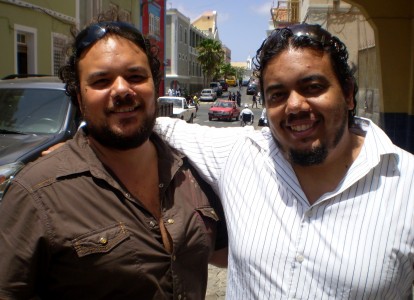
Two entrepreneurial brothers, Paulo and Ary Abu-Raya, opened a real estate office in Mindelo, Sao Vicente, to develop and sell real estate to Europeans and Americans looking for leisure and commercial properties. (Photo Ron Bernthal).
In 2008, just when tourism development on the island began to take off, at least in the blueprint stage, Ary Abu-Raya left Boston and returned home, to Mindelo, opening a real estate office in the center of town with his brother, Paulo. In those days, Mr. Abu-Raya and his brother, both in their early 30′s, took overseas buyers around the island, showing them everything from charming Portuguese colonial homes with harbor views for 250,000 Euros (about $300,000), to large tracts of pristine beachfront property a few minutes outside of town. The Cabo Verde government makes it easy for non-residents to purchase land here for residential or commercial use, and while the infrastructure on some of the islands is not yet ready for mass tourism, it is hard not to notice some of the residential development projects that had started on São Vicente.
One morning during my visit I took a self-guided tour of the island, visiting an area called Baia das Gatas, a beautiful beachfront property where a five star hotel resort and residences, Fortim Mindelo, part of the well known Nikki Beach brand, was under development, along with an Ernie Els-designed PGA golf course. Nearby, the concrete shells of vacation homes protruded from the dry, rugged hillsides overlooking the Atlantic.
On another part of the island San Pedro Village is a posh development on São Pedro Bay. Its 408 apartments and 114 townhouses are modern and refined versions of Cabo Verdean Creole architecture. Some buildings surround a large tropical pool, while others line both sides of a narrow street facing each other. About 60 ground floor units of the 2- to 4-level apartments are used as commercial spaces, housing restaurants, cafés, shops, boutiques, bars, and snacks stations. The picturesque village is designed for tourists with boats or yachts. There is a marina, a shipyard, a fisherman’s port, and a fuel station. Although some of the Baia das Gatas units have been completed, many have not, or are being rented out as AirBnB’s.
Mindelo in São Vicente is possibly the prettiest city in Cabo Verde. Towering over it is the island’s highest peak, Monte Verde. The area around the port is a busy, with a curving harbor filled with fishing boats and, often during winter, a few large yachts as well. Pastel-colored buildings and houses line the shaded, cobble-stoned streets.
The town, which is the country’s cultural center for music and art, hosts a steady flow of tourists coming to check out festivals or mingle with locals in bars and restaurants. It becomes particularly lively and crowded during the country’s popular Mardi Gras festival.
A new cultural venue on São-Vicente is also about to be completed. NLÉ and Kunlé Adeyemi have designed a prefabricated floating music hub currently in construction just offshore in Mindelo Bay. (See banner photo top of page)
Work is progressing on the Floating Music Hub, NLÉ’s latest incarnation of the Amsterdam- and Lagos-based architecture studio’s Makoko Floating System (MFS™). The project, which is set to complete in December, 2020, is designed to host a variety of activities with musical performances, lectures and music classes, enhancing the region’s cultural infrastructure and showcasing Cabo Verde’s creative output and heritage.
The timber structure consists of three vessels of varying sizes, which will be anchored around a triangular floating public plaza, creating a little creative ‘village’. These distinct floating wings will host a multipurpose performance hall (in the MFS™ large), a professional recording studio (in MFS™ medium) and a service bar (in MFS™ small). They all feature the system’s signature triangular shape and pitched roof.
The project was conceived by NLÉ principal and founder Kunlé Adeyemi, and is the latest version of his Makoko Floating System (MFS™), a prefabricated design engineered to higher performance specifications and quality for marine environments. A prototype was first launched to the public in 2012 with the Makoko Floating School in Nigeria, and was conceived “to generate sustainable, ecological, alternative building systems and urban water cultures for the teeming population of Africa’s coastal regions,” said Mr. Adeyemi.
The concept has since been modified and perfected, with the Cabo Verde’s upcoming completion marking the system’s first edition to be created in the Atlantic Ocean, a new territory for the NLE team’
Orésimo Silveira is a well-known figure on São Vicente. A spry and vibrant gentleman close to 80 years old, with deep-set eyes and a frizzy gray beard, he helped lead Cabo Verde’s independence movement from Portugal, becoming the Cabo Verdean ambassador to their former colonial overseer following independence in 1975. “Large scale development plans have been underway on São Vicente for the past 10 years, and there are lots of investors still coming in to look around, but big changes will not happen overnight, there is still a lot of ground to cover, ” said Dr. Silveira.
The terrain on São Vicente is typical of Cabo Verde, stunning but raw. These desperately dry islands have suffered drought for what seems like centuries, and fresh water is scarce and expensive. Desalination plants help somewhat, as do wind turbines, which catch the ocean breezes and create electrical power for deep wells.
Cabo Verde has set itself a very bold renewable energy target. As part of its “sustainable energy for all” agenda, it has pledged to obtain 100% of its electricity from renewable resources by 2025. Almost all of the islands’ 550,000 residents have access to electricity, but about one-third still rely on firewood and charcoal for cooking. Cape Verde’s per capita electricity consumption of 727 kWh per person per year is substantially higher than the sub-Saharan Africa average of 488 kWh per person per year. But electricity prices are high.
Although most of its electricity is produced by generators, which run on imported petroleum products, Cabo Verde has started to diversify its energy portfolio. A quarter is now provided by renewable sources. This is good news because between 2015 and 2020, Cabo Verde has will almost doubled its annual electricity consumption due to new residential and hotel projects on the islands.
With cutting-edge technologies and innovative business practices, Cabo Verde can achieve its 100% renewable energy goal in a way that is cost-effective and equitable. One research report suggested that a system based on solar, wind and energy storage (as batteries and pumped hydropower) could meet Cabo Verde’s goals. It certainly has a wide range of options for increasing its share of renewable energy to achieve this, while some small countries obtain almost all of their electricity from renewable sources, these countries usually have substantial hydroelectric resources. But Cabo Verde, lacking large hydropower resources, would be unique in achieving 100% renewable energy with a diverse resource mix.
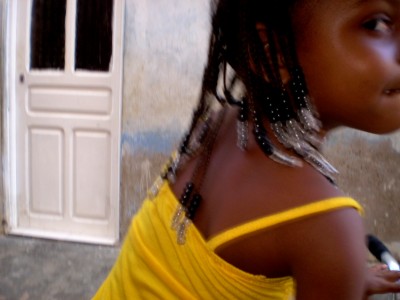
A young girl rides her bicycle along one of the residential streets in Praia, Cabo Verde’s busy capital city. (Photo Ron Bernthal)
Cape Verde’s northeasterly trade winds are considered excellent for wind power production. A wind farm typically requires wind speeds of at least 6.4 m/s at 50m above ground. Cape Verde’s average annual wind speeds exceed 9.0 m/s at the wind farm. Already three of the islands, including the two most populated, produce about 25% of their electricity from wind turbines. But without energy storage there is little opportunity to expand wind energy on these islands.
Another technology that could be integrated into the electricity generation offering is the country’s desalination systems. Many of Cape Verde’s communities depend partially, or entirely, on these for drinking water. Desalination systems require electricity and can be run at times when the wind turbines are operating, but electricity demand is low, such as at night.
Like many African countries, Cabo Verde’s tropical location also has good potential for solar photovoltaic (PV) electricity. One study says that the solar PV capacity potential is more than double the currently installed electrical generating capacity. Most of the potential development is on the densely populated island of Santiago. The challenge, as with wind, is integrating irregular flows into the grid.
If the islands expect to keep building luxury resorts and year-round housing units for the overseas market, however, the water supply, as well as the fragile electricity service, will need to be upgraded in order to keep up with the additional amenities that big-time destinations need… gas stations, shops, supermarkets, golf courses, spas, and easily accessible high speed WiFi. The Cabo Verde government is presently working with overseas firms to develop large solar and wind farms on the islands of Sal and Santiago.
The Cabo Verdeans, descendants of African slaves and 17th century seafarers from Europe, seem to be both patient and anxious as they wait for all the large scale development projects to come to fruition, and for the changes in their lifestyle that will surely result. “We are a mix of cultures here on São Vicente,” said Sueli Duarte, 27, a teacher who works with children from Mindelo’s poorest families. “It is sad that so many of our citizens still must leave the island to work overseas, it is bad for the psyche. If the economy can be improved on the island, many more people would return from Europe and the U.S. to work here, and live with their extended families, in their own culture.”
When I was leaving São Vicente for my short flight to the island of Sal, I noticed the new international terminal building at Sao Pedro Airport, which allows the facility to handle overseas cargo and passenger flights directly from Europe and Brazil, Cabo Verde’s Portuguese-speaking trading and cultural partner. This will help to increase passenger arrivals into São Vicente and spur additional commercial and residential investment.
For the island of Sal, which has been receiving direct overseas flights for 20 years, mass tourism has been the island’s economic engine for decades, and Sal is poised to host even larger numbers of visitors. The island’s salt ponds were first harvested in the 15th century, but that ended in the early 1900′s and today most of Sal is hot, dry, and flat, with starkness reminiscent of the American southwest desert. Since jets began ferrying tourists to the first beachfront hotels here, Sal has earned a reputation as a pleasant, care-free island with plenty of excellent fishing, windsurfing, and scuba diving, an inexpensive holiday for middle-class British tourists needing to escape the U.K’s dreary winter weather.
The busy, but quiet, ambience of Sal, however, is changing dramatically. The expanse of desert-like terrain near the tourist town of Santa Maria is cluttered with construction equipment, cranes, and half-built condos and shopping centers. New vacation and resort communities, with names like Cotton Bay, White Sands, Calheta Bay, Paradise Beach and Murdeira Beach have sprouted up all along the wide sand beaches outside of Santa Maria. Although many new properties have already opened, others have suspended construction, waiting for financial markets and international travel to return to 2019 levels. .
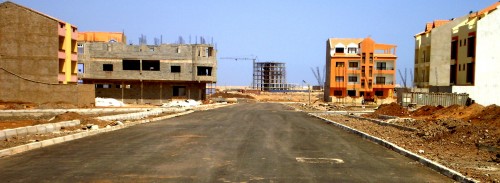
New construction in Santa Maria, on the island of Sal, is attracting visitors from the UK, Germany, and other northern European countries who wish to purchase affordable seaside residential or commercial properties in Cabo Verde. (Photo Ron Bernthal).
The largest island in Cape Verde, Santiago, is the country’s economic center, and Praia, its largest town, is the country’s capital. Although Santiago has two mountain ranges, lush agricultural valleys with banana plantations, and more water than the other islands, it is mostly a business destination, with few tourists electing to spend their two-week vacation in the gritty capital city.
There are several upscale hotels in Praia, where business travelers and government workers enjoy the proximity to embassies and the parliament building, but it is in the hot and busy streets of Praia where Cape Verde’s African influence really becomes apparent. The barefoot school boys playing soccer on dirt fields; women selling clothing, fruit, music CD’s, t-shirts, and buckets of fresh fish at the outdoor market; small barbeque stands offering inexpensive fresh grilled fish and chicken that appear on the streets at sunset; and the lively and gracious nature of the Cabo Verdeans bring the culture, sounds, and smells of West Africa to visitors.
It is from the government offices in Praia that the country’s plan for major tourism development is being pushed forward. With real estate marketers calling the country the “Caribbean of Europe,” and the International Monetary Fund praising its safe and liberal investment opportunities, Cabo Verde has managed to maintain economic growth during Europe’s economic problems; although perhaps not at the pace everyone had been hoping for.
© Ron Bernthal – No editorial content, portions of articles, or photographs from this site may be used in any print, broadcast, or Web-based format without written permission from the author or Web site developer.

